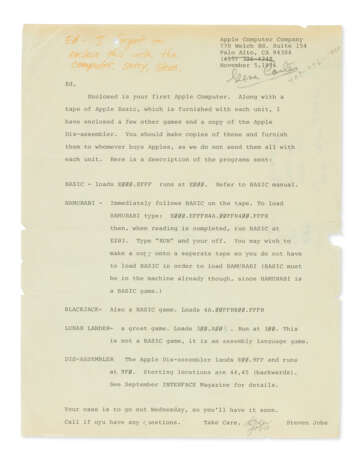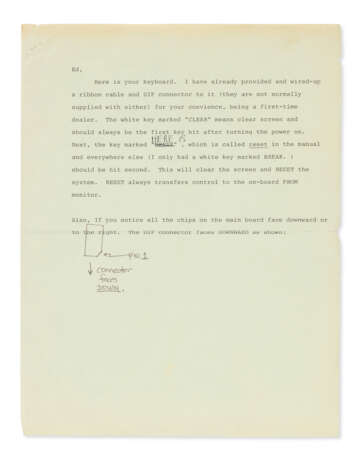ID 1279153
Los 9 | "ENCLOSED IS YOUR FIRST APPLE COMPUTER..."
Schätzwert
$ 50 000 – 80 000
STEVE JOBS, 5 NOVEMBER 1976
Two typed letters, the first with autograph manuscript note and signed twice ("steven jobs" and "Steve"), to Ed [Faber], Palo Alto, 5 November 1976.
The nineteen-year-old Steve Jobs provides instructions on selling the Apple-1 computer to a Bay Area retailer, advising him to make copies of some additional software (games and the Apple dis-assembler) and give them away to his customers.
"Type 'RUN' and your off." This is the earliest Apple-1 letter that we trace in the auction records; as a Jobs-signed Apple item, it is preceded by only company checks. The address on the letterhead for "Apple Computer Company" is to a mail service. Jobs and Woz and their small team were still working out of Jobs's parents house at this point, where the first Apple-1s had been built just a few months before.
Steve Jobs details five programs that accompanied the Apple-1. This includes three games: HAMMURABI, an early text-based simulation game developed in BASIC by Doug Dyment in 1968 and adapted by David H. Ahl in 1973; BLACKJACK, similarly a text-based program that simulated the card-game; and LUNAR LANDER, "a great game" developed specifically for DEC PDP-8, in which players controlled a lunar module's descent onto the moon's surface. Two further running programs were included: BASIC, "Beginner's All-purpose Symbolic Instruction Code" a high-level programming language created in 1964 by John G. Kemeny and Thomas E. Kurtz, designed to be easy to learn and use; and DIS-ASSEMBLER, a software tool used to convert machine code back into assembly language – the Apple DIS-ASSEMBLER only became a standard addition with the release of Apple-II.
Littered with spelling errors and hand-written corrections by Steve Jobs himself, this instruction guide was typed when he was 19 years old. While his corrections speak to a commercial standard still in development, the addition at the top of the handwritten name and phone number of Gene Carter, Apple’s first Sales Manager, attests to the early growth of the company. Steve’s postscript, written in orange felt-tip, "Ed- I forgot to include this with the computer. sorry, steve," captures the early inexperience of a teenager, yet to become an international phenomeon. Indeed, in the year 1976, Jobs was famously operating out of his parents' house in Los Altos, California, where all 200 Apple-1 computers were produced. Tellingly, the address given at the top of the letter is to a mail drop near Jobs's family home, which was also used on the company’s early answering service; this “business” address further reveals the dichotomy between appearances and reality, the young Jobs and co. playing catch-up with the rapid and exponential growth of their creation – teenagers on the brink of unfathomable success. The second letter transmits a keyboard to Ed and is certainly from the same period, but is not signed by Jobs nor are the handwritten corrections in his hand. It is fascinating that, according to these letters, this very early Apple-1 dealer was sent the computer, and its accompanying case and keyboard in three separate shipments.
This breakthrough in the microcomputer revolution would change the entire landscape of the computing world, giving birth to what is now known as Silicon Valley, and facilitating a rapidly growing business dealership market. Firms such as Sears, Computer City and ComputerLand (formally Computer Shack) began appearing in the California area, brokering deals between inventors, programmers, and the general market. It is within this purpose that these remarkable letters came to creation, Jobs writing to a dealer simply referred to as "Ed" – almost certainly Edward Faber. At the dating of this letter, Faber had just been appointed president of ComputerLand, having previously been a Manager at IBM (International Business Machine Corporation). Opening the first shop in Hayward, California, Faber pioneered the concept of the ‘full service’ store, in which customers could buy, service and purchase additional computer products at a one-stop shop. The success of his model saw ComputerLand franchised throughout the United States of America, echoing the growth of the microcomputer market brought about by the success of Jobs' Apple-I and future models.
The Ed Faber Apple-1 is available as lot 133 in Firsts: The History of Computing from the Paul G. Allen Collection, selling online with bids closing on September 12th.
Provenance
Ed [Faber, the founding president of Computerland Inc., November 1976].
Luke Snyder, Farnsworth Computer Center, Aurora, Illinois.
Acquired from the above by a private collector, 1991.
Acquired by the late owner, 2005.
| Kategorie des Auktionshauses: | Briefe, Dokumente und Manuskripte, Bücher und Handschriften |
|---|
| Kategorie des Auktionshauses: | Briefe, Dokumente und Manuskripte, Bücher und Handschriften |
|---|
| Adresse der Versteigerung |
CHRISTIE'S 8 King Street, St. James's SW1Y 6QT London Vereinigtes Königreich | |
|---|---|---|
| Vorschau |
| |
| Telefon | +44 (0)20 7839 9060 | |
| Aufgeld | see on Website | |
| Nutzungsbedingungen | Nutzungsbedingungen |




